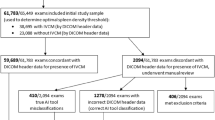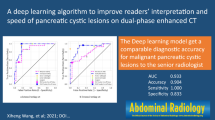Abstract
Objectives
To develop and validate an open-source artificial intelligence (AI) algorithm to accurately detect contrast phases in abdominal CT scans.
Materials and methods
Retrospective study aimed to develop an AI algorithm trained on 739 abdominal CT exams from 2016 to 2021, from 200 unique patients, covering 1545 axial series. We performed segmentation of five key anatomic structures—aorta, portal vein, inferior vena cava, renal parenchyma, and renal pelvis—using TotalSegmentator, a deep learning-based tool for multi-organ segmentation, and a rule-based approach to extract the renal pelvis. Radiomics features were extracted from the anatomical structures for use in a gradient-boosting classifier to identify four contrast phases: non-contrast, arterial, venous, and delayed. Internal and external validation was performed using the F1 score and other classification metrics, on the external dataset “VinDr-Multiphase CT”.
Results
The training dataset consisted of 172 patients (mean age, 70 years ± 8, 22% women), and the internal test set included 28 patients (mean age, 68 years ± 8, 14% women). In internal validation, the classifier achieved an accuracy of 92.3%, with an average F1 score of 90.7%. During external validation, the algorithm maintained an accuracy of 90.1%, with an average F1 score of 82.6%. Shapley feature attribution analysis indicated that renal and vascular radiodensity values were the most important for phase classification.
Conclusion
An open-source and interpretable AI algorithm accurately detects contrast phases in abdominal CT scans, with high accuracy and F1 scores in internal and external validation, confirming its generalization capability.
Clinical relevance statement
Contrast phase detection in abdominal CT scans is a critical step for downstream AI applications, deploying algorithms in the clinical setting, and for quantifying imaging biomarkers, ultimately allowing for better diagnostics and increased access to diagnostic imaging.
Key Points
-
Digital Imaging and Communications in Medicine labels are inaccurate for determining the abdominal CT scan phase.
-
AI provides great help in accurately discriminating the contrast phase.
-
Accurate contrast phase determination aids downstream AI applications and biomarker quantification.



Similar content being viewed by others
Abbreviations
- AI:
-
Artificial intelligence
- AUPRC:
-
Area under precision-recall curve
- AUROC:
-
Area under the receiver operating characteristic curve
- CT:
-
Computed tomography
- DICOM:
-
Digital Imaging and Communications in Medicine
- IVC:
-
Inferior vena cava
- SHAP:
-
Shapley additive explanations
- XGBoost:
-
Extreme gradient boosting
References
Kammerer S, Höink AJ, Wessling J et al (2015) Abdominal and pelvic CT: Is positive enteric contrast still necessary? Results of a retrospective observational study. Eur Radiol 25:669–678
Shirkhoda A (1991) Diagnostic pitfalls in abdominal CT. Radiographics 11:969–1002
Radiya K, Joakimsen HL, Mikalsen KØ, Aahlin EK, Lindsetmo R-O, Mortensen KE (2023) Performance and clinical applicability of machine learning in liver computed tomography imaging: a systematic review. Eur Radiol. https://doi.org/10.1007/s00330-023-09609-w
Rocha BA, Ferreira LC, Vianna LGR et al (2022) Contrast phase recognition in liver computer tomography using deep learning. Sci Rep 12:20315
Schieda N, Nguyen K, Thornhill RE, McInnes MDF, Wu M, James N (2020) Importance of phase enhancement for machine learning classification of solid renal masses using texture analysis features at multi-phasic CT. Abdom Radiol (NY) 45:2786–2796
Han S, Hwang SI, Lee HJ (2019) The classification of renal cancer in 3-phase CT images using a deep learning method. J Digit Imaging 32:638–643
Boutin RD, Kaptuch JM, Bateni CP, Chalfant JS, Yao L (2016) Influence of IV contrast administration on CT measures of muscle and bone attenuation: implications for sarcopenia and osteoporosis evaluation. AJR Am J Roentgenol 207:1046–1054
Pickhardt PJ, Lauder T, Pooler BD et al (2016) Effect of IV contrast on lumbar trabecular attenuation at routine abdominal CT: correlation with DXA and implications for opportunistic osteoporosis screening. Osteoporos Int 27:147–152
Rühling S, Navarro F, Sekuboyina A et al (2022) Automated detection of the contrast phase in MDCT by an artificial neural network improves the accuracy of opportunistic bone mineral density measurements. Eur Radiol 32:1465–1474
Jang S, Graffy PM, Ziemlewicz TJ, Lee SJ, Summers RM, Pickhardt PJ (2019) Opportunistic osteoporosis screening at routine abdominal and thoracic CT: normative L1 trabecular attenuation values in more than 20 000 adults. Radiology 291:360–367
Ye Z, Qian JM, Hosny A et al (2022) Deep learning-based detection of intravenous contrast enhancement on CT scans. Radiol Artif Intell 4:e210285
Na S, Sung YS, Ko Y et al (2022) Development and validation of an ensemble artificial intelligence model for comprehensive imaging quality check to classify body parts and contrast enhancement. BMC Med Imaging 22:87
Muhamedrahimov R, Bar A, Laserson J, Akselrod-Ballin A, Elnekave E (2022) Using machine learning to identify intravenous contrast phases on computed tomography. Comput Methods Programs Biomed 215:106603
Blankemeier L, Yao L, Long J et al (2024) Skeletal muscle area on CT: determination of an optimal height scaling power and testing for mortality risk prediction. AJR Am J Roentgenol 222:e2329889
Chartrand G, Cheng PM, Vorontsov E et al (2017) Deep learning: a primer for radiologists. Radiographics 37:2113–2131
Fuentes-Orrego JM, Pinho D, Kulkarni NM, Agrawal M, Ghoshhajra BB, Sahani DV (2014) New and evolving concepts in CT for abdominal vascular imaging. Radiographics 34:1363–1384
Blankemeier L, Desai A, Chaves JMZ et al (2023) Comp2Comp: open-source body composition assessment on computed tomography. Preprint at https://doi.org/10.48550/ARXIV.2302.06568
Gauriau R, Bridge C, Chen L et al (2020) Using DICOM metadata for radiological image series categorization: a feasibility study on large clinical brain MRI datasets. J Digit Imaging 33:747–762
Reis EP, De Paiva JPQ, Da Silva MCB et al (2022) BRAX, Brazilian labeled chest x-ray dataset. Sci Data 9:487
Wasserthal J, Breit H-C, Meyer MT et al (2023) TotalSegmentator: robust segmentation of 104 anatomic structures in CT images. Radiol Artif Intell 5:e230024
Chowdhary CL, Acharjya DP (2020) Segmentation and feature extraction in medical imaging: a systematic review. Procedia Comput Sci 167:26–36
Van Timmeren JE, Cester D, Tanadini-Lang S, Alkadhi H, Baessler B (2020) Radiomics in medical imaging—“how-to” guide and critical reflection. Insights Imaging 11:91
Chen T, Guestrin C (2016) XGBoost: a scalable tree boosting system. In: Proceedings of the 22nd ACM SIGKDD international conference on knowledge discovery and data mining, San Francisco, 13–17
Dao BT, Nguyen TV, Pham HH, Nguyen HQ (2022) Phase recognition in contrast‐enhanced CT scans based on deep learning and random sampling. Med Phys 49:4518–4528
Clopper CJ, Pearson ES (1934) The use of confidence or fiducial limits illustrated in the case of the binomial. Biometrika 26:404–413
Acknowledgements
We would like to acknowledge the team behind the TotalSegmentator open-source project, for their work on Abdominal CT segmentations. We would like to acknowledge funding from the NIH, Stanford Precision Health and Integrated Diagnostics Seed Grant, Stanford Human-Centered AI, and Center for AI in Medicine and Image Seed Grant.
Funding
This study has received funding from NIH NHLBI R01 HL167974, Stanford Precision Health and Integrated Diagnostics Seed Grant; Stanford Human-Centered AI, and Center for AI in Medicine and Image Seed Grant.
Author information
Authors and Affiliations
Corresponding author
Ethics declarations
Guarantor
The scientific guarantor of this publication is Eduardo Pontes Reis.
Conflict of interest
The authors of this manuscript declare no relationships with any companies, whose products or services may be related to the subject matter of the article.
Statistics and biometry
No complex statistical methods were necessary for this paper.
Informed consent
Written informed consent was waived by the Institutional Review Board.
Ethical approval
Institutional Review Board (Stanford University School of Medicine) approval was obtained.
Study subjects or cohorts overlap
The study subjects or cohorts have not been previously reported.
Methodology
-
Retrospective
-
Diagnostic study
-
Performed at one institution
Additional information
Publisher’s Note Springer Nature remains neutral with regard to jurisdictional claims in published maps and institutional affiliations.
Rights and permissions
Springer Nature or its licensor (e.g. a society or other partner) holds exclusive rights to this article under a publishing agreement with the author(s) or other rightsholder(s); author self-archiving of the accepted manuscript version of this article is solely governed by the terms of such publishing agreement and applicable law.
About this article
Cite this article
Reis, E.P., Blankemeier, L., Zambrano Chaves, J.M. et al. Automated abdominal CT contrast phase detection using an interpretable and open-source artificial intelligence algorithm. Eur Radiol (2024). https://doi.org/10.1007/s00330-024-10769-6
Received:
Revised:
Accepted:
Published:
DOI: https://doi.org/10.1007/s00330-024-10769-6




